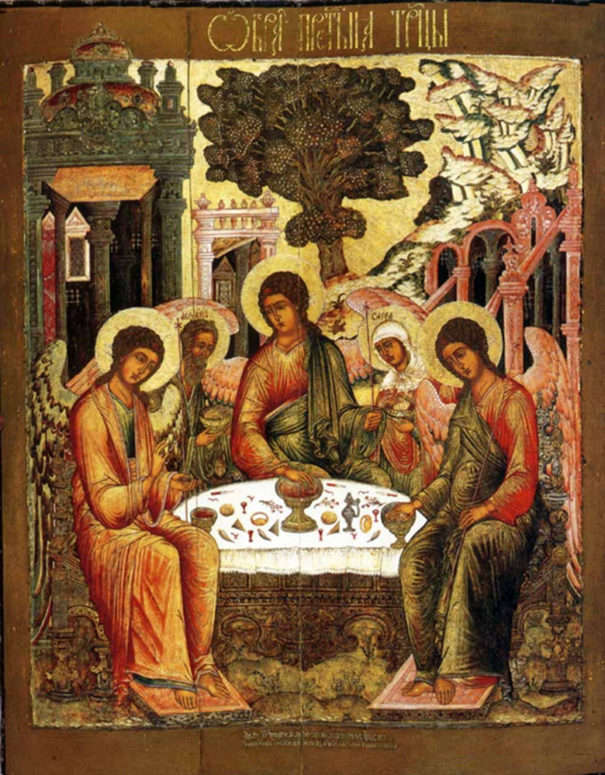
Gurias Nikitin had a rare feeling of plasticity for a medieval painter. He knew how to make figures dynamic, lively and, ultimately, temperamental. The Tsar and Patriarch, metropolitans and archimandrites fought for the privilege to have him do icon painting for them.
It was in the 17th century. In the 1660s, the painting of the Archangel Cathedral of the Moscow Kremlin under the supervision of Simon Ushakov, the Tsar’s isographer, was resumed. Emelian Pushkarev, who had been sent from Moscow to Kostroma due to leg problems, names Gurias Nikitin, the son of Kineshemtsev, among the other iconographers available in Kostroma. By that time, he must have already had enough experience and skill, because otherwise he would not have passed the exam to become a first-class icon painter.
It is known that he was born in Kostroma around 1620, to a family in which there had not been any icon painters and that he was “a God-endowed artist”. At that time, the labor of icon painters was held in high esteem – not for the artistic qualities of their works as such, but rather for “the honor of depicting holy icons”. Some court icon painters were even awarded nobility titles, but there were few such artists. Most icon painters were treated like chattel slaves and punished by whips if they didn’t perform their duties well enough.
It remains unknown who taught Gurias the art of icon painting. One of his first works is the Fyodorovskaya Icon of the Mother of God, located in the St. Joachim and Anna Church in Kostroma. There was an inscription on the icon saying that the icon was painted by Gurias Nikitin on March 10, 1659.
Soon Gurias Nikitin becomes the head of the Kostroma icon painters’ artel. They are invited to paint the Trinity Cathedral of Danilov Monastery in Pereslavl-Zalessky. The painting on vaults (Annunciation, Descent to Hell, Ascension, Nativity of the Mother of God) and the altar (Sacrificial Lamb, Washing of Feet, etc.) belongs to the artist himself. His frescoes reflect the inherent style of his painting: the method of “non-mirror” symmetry of composition, a feeling of rhythm, the inner dynamics of images, energetic plastic modeling of shapes, the contrasts of light and shadow. Gurias Nikitin boldly approaches non-canonical scenes (in The Apocalypse), showing creative imagination and a natural gift of a decorator.
It is well known that Gurias Nikitin participated in the painting of the already mentioned Archangel Cathedral in 1660-1666. He painted the Assumption Cathedral (1670-1671) and the Church of the Resurrection (1675) in Rostov the Great, where he painted frescoes on the Holy and Easter Weeks. It was discovered thanks to a number of techniques emblematic of the painter: the movement of shapes from bottom to top in four tiers and the increase of their dynamics in the same direction. Frescoes of the upper tiers are saturated with air, in which the figures seem to float, expressing the architectural idea of the temple as the House of God. The Assurance of Thomas, Descent of the Holy Spirit and Ascension, ascribed to Gurias Nikitin, express his understanding of the interrelation between architecture and painting, which is typical of the artist, reflected in the compositional relations of figures, landscape, architectural motifs, all of which are fully subordinate to the wall surface. Wide range of colors – whitewash, ochre, lapis lazuli, cinnabar – ensures a colorful, ornate impression. The most significant fragments of compositions are highlighted with color.
Paintings of the Church of St. Elijah the Prophet in Yaroslavl in 1680, the Trinity Cathedral of the Ipatiev Monastery in Kostroma in 1684 and the Transfiguration Cathedral of the Savior Euphemiav Monastery in Suzdal in 1689 are among the best achievements of decorative arts and crafts of the second half of the 17th century.
When painting the Church of Elijah the Prophet in Yaroslavl, the artist came up with a new technique, which researchers later called “the Gurias Nikitin’s formula”: he conveyed the feeling of space by depicting a transparent house, which could be seen from both inside and outside at the same time. The painter modified and interpreted the prints from the Piscator’s Bible at his own discretion, creating original compositions of the same genre.
The figures of people crowded in the narrow space limited by architectural or landscape “backstage” are usually in a state of turbulent, multidirectional movement, which is surprisingly orderly with the composition itself always balanced and symmetrical.
Gurias Nikitin’s last work – paintings in the Spaso-Yevfimiyev Monastery – is similar to his previous works in terms of iconographic composition and even ornamental motifs.
Gurias Nikitin died in 1691 in Kostroma, “as a godly man who feared God and lived in virginity, even to his death,” according to a random mention in a book eighteen years after his death, which also serves as an evidence that the residents of Kostroma remembered the name of their famous compatriot, even after such a long time.








